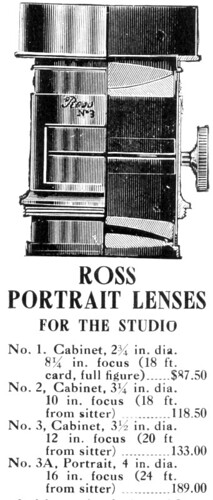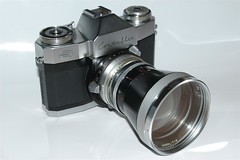Difference between revisions of "Portrait lens"
(major re-write) |
m (missing "a") |
||
| Line 13: | Line 13: | ||
This requires focal lengths of about 1.5 to 2.5 times the image diagonal of the film or [[sensor]] format. In other words, 45mm would be considered a "portrait" focal length on the sensor size of a [[Micro Four Thirds]] camera; while a 300mm lens would give the equivalent angle of view on a 4x5 [[view camera]]. | This requires focal lengths of about 1.5 to 2.5 times the image diagonal of the film or [[sensor]] format. In other words, 45mm would be considered a "portrait" focal length on the sensor size of a [[Micro Four Thirds]] camera; while a 300mm lens would give the equivalent angle of view on a 4x5 [[view camera]]. | ||
| − | Another consideration for portraiture is that the photographer will likely wish to blur the background to de-emphasize distracting detail. A portrait lens typically offers relatively large [[entrance pupil]] (the physical diameter of the aperture) which greatly facilitates this. For this reason, portrait lenses offering speeds of f/2.0 or wider may become some of the most sought-after items in a particular manufacturer's lens lineup. | + | Another consideration for portraiture is that the photographer will likely wish to blur the background to de-emphasize distracting detail. A portrait lens typically offers a relatively large [[entrance pupil]] (the physical diameter of the aperture) which greatly facilitates this. For this reason, portrait lenses offering speeds of f/2.0 or wider may become some of the most sought-after items in a particular manufacturer's lens lineup. |
Beyond simply offering selective focus to a photographer, portrait lenses may be explicitly designed to provide pleasing [[bokeh]]—the perception of softness and smoothness in the out-of-focus area. In some cases this may involve deliberate undercorrection of spherical aberration or other aberrations ( "clinically sharp" performance may not be the desired goal for pleasing portraiture). Some manufacturers go further, and offer dedicated soft-focus portrait lenses: these may provide adjustable amounts of spherical aberration, or aperture stops with multiple perforations, with the result that highlights show a slight halo around them. | Beyond simply offering selective focus to a photographer, portrait lenses may be explicitly designed to provide pleasing [[bokeh]]—the perception of softness and smoothness in the out-of-focus area. In some cases this may involve deliberate undercorrection of spherical aberration or other aberrations ( "clinically sharp" performance may not be the desired goal for pleasing portraiture). Some manufacturers go further, and offer dedicated soft-focus portrait lenses: these may provide adjustable amounts of spherical aberration, or aperture stops with multiple perforations, with the result that highlights show a slight halo around them. | ||
Revision as of 21:33, 7 April 2011

|
| the Ross Portrait Lens, a design similar to the Petzval lens |
Portrait lens is the general term for a lens suitable for making pleasing portraits, i.e. a photograph showing a subject's face and perhaps a bit of their shoulders.
If a photographer tries to make such a portrait from too close a position (say, under 2.5 feet or 75 cm) the subject's nose can appear unattractively exaggerated. On the other hand, an image made with a long telephoto from extreme distances will show the sides of the head to an unnatural degree, making it appear ballooned out. Thus, a "portrait" focal length is one allowing the photographer to frame a head-and-shoulders shot from some middle distance—perhaps 5 feet or 1.5 meters.
This requires focal lengths of about 1.5 to 2.5 times the image diagonal of the film or sensor format. In other words, 45mm would be considered a "portrait" focal length on the sensor size of a Micro Four Thirds camera; while a 300mm lens would give the equivalent angle of view on a 4x5 view camera.
Another consideration for portraiture is that the photographer will likely wish to blur the background to de-emphasize distracting detail. A portrait lens typically offers a relatively large entrance pupil (the physical diameter of the aperture) which greatly facilitates this. For this reason, portrait lenses offering speeds of f/2.0 or wider may become some of the most sought-after items in a particular manufacturer's lens lineup.
Beyond simply offering selective focus to a photographer, portrait lenses may be explicitly designed to provide pleasing bokeh—the perception of softness and smoothness in the out-of-focus area. In some cases this may involve deliberate undercorrection of spherical aberration or other aberrations ( "clinically sharp" performance may not be the desired goal for pleasing portraiture). Some manufacturers go further, and offer dedicated soft-focus portrait lenses: these may provide adjustable amounts of spherical aberration, or aperture stops with multiple perforations, with the result that highlights show a slight halo around them.
The first portrait lens was the Petzval lens, invented in 1841 by Jozef Maximilián Petzval. This was a portrait lens by virtue of its greatly-improved aperture. Previous lenses of the era demanded exposure times measured in minutes, whilst the Petzval lens could reduce exposure time to a more tolerable 30 seconds. The residual aberrations of the Petzval design give it a softness which a few portrait photographer continue to find useful today.
35mm cameras with portrait lenses

|

|

|
| Helios-40 85mm f1.5 | Canon FDn 100mm f2.0 | Pro-Tessar 115mm f4.0 |
| image by Siim Vahur (Image rights) | image by Voxphoto (Image rights) | image by John F Richardson (Image rights) |